Article's Content
Since its founding in 2015, Upwork has effectively used SEO strategies to maintain its dominance within the freelancing industry. This case study will examine how Upwork used long-tail keywords to rise to the top of an extremely competitive industry and what your company can learn from these critical strategies.
Unlike legendary brands like Apple and Amazon, which were born in garages, Upwork resulted from the merger of two established brands. Elance was a groundbreaking freelance platform founded in 1998, and oDesk was another industry leader founded five years later.
Upwork’s business model is to connect clients with skilled freelancers. Although Upwork takes a commission between 5-20% from their pay for each assignment, freelancers have access to top-tier assignments, more reliable payments, and the chance to promote their work to a vast audience.
Clients, on the other hand, seek freelancers on the marketplace because it is a simpler and more reliable way to find the freelance talent they require. A vast army of talent is ready to contribute, from computer programmers to videographers to copywriters. Upwork’s platform makes communication, time tracking, and other essential functions easier and more secure.
It’s interesting to note that Upwork is the type of business that practices what it preaches. Around 75% of their internal workforce is freelancers, and 100% of their departments embrace a hybrid approach. Most tellingly, their employees are based in 86 countries around the world, highlighting the global reach made possible with freelance labor.
Although Upwork was already successful before 2020, the business has exploded since the pandemic created work-from-home environments in global markets. Whether or not clients want to participate in the gig economy is irrelevant, as the realities of today often make it a requirement.
Upwork boasts a roster of more than 145,000 clients, including half of the Fortune 500 corporations. Clients typically see substantial cost savings over hiring a full-time employee because freelance talent is flexible and on-demand rather than being a permanent fixture on the payroll.
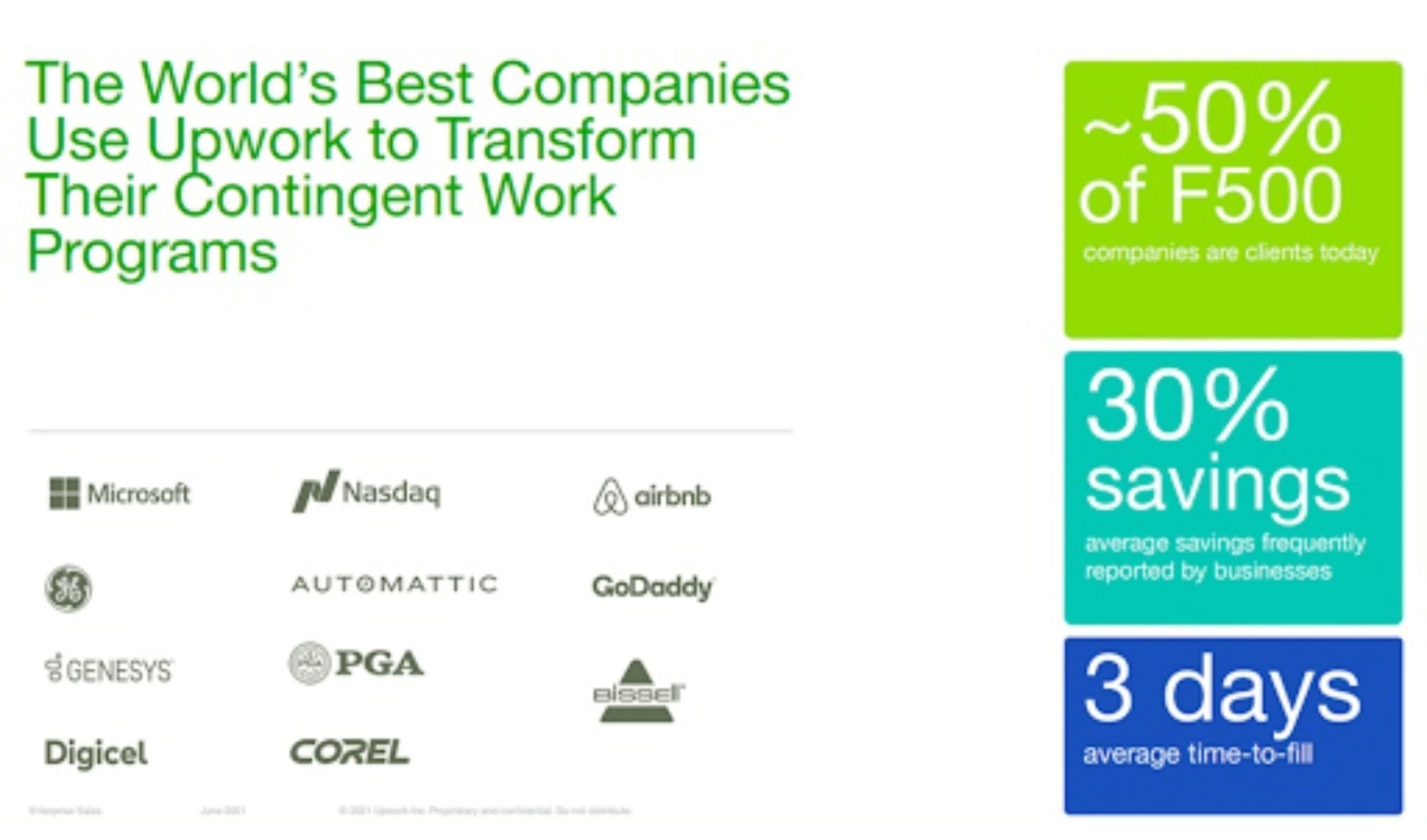

Source: Upwork.com
Consider these freelancing stats from the Freelance Forward 2021 report:
- 59 million Americans worked freelance in 2021 (36% of the total workforce)
- 56% of those who don’t currently freelance plan to start in the future
- 70% of freelancers outpaced their full-time job earnings in less than a year
- 65% of freelancers expect their income to increase next year
- Freelancers contributed $1.3 trillion in annual earnings to the US economy
- 51% of post-grad workers are choosing freelancing in their careers
As the global job market struggles with talent shortages and disruptive attrition rates, there’s no doubt that freelancing is here to stay. An influx of skilled IT workers who have left full-time jobs in favor of freelancing only strengthens the case.
A talent platform like Upwork is essential for many businesses to connect with the right freelance contributors. But its success has obviously spurred a scramble of new competitors, including industry titans such as Fiverr and Toptal.
“A simple problem drives the growth of freelancing: Talent is distributed equally around the world, but opportunity isn’t,” says Rich Pearson, Upwork’s SVP of Marketing.
“Technology has helped Upwork solve this, and while we are the largest freelancing site in the world, the labor market is enormous, which allows smaller niche sites to target different segments of the market. It’s hard to keep up with all the different sites trying to attack the same problem.”
How is Upwork maintaining its preeminent spot in the freelancing world? It all starts on the search engine results page (SERP).
Using the Right Keywords for the Right Results
Consider the role of marketplaces when it comes to serving the needs of clients. As aggregators of resources, a platform doesn’t necessarily need to educate clients on why they should purchase. Rather, they need a unique sales proposition that clearly communicates why the client should use them instead of simply acquiring the resource independently.
The resources sought in the job markets where Upwork makes money are talented individuals who can contribute on a short-term basis. Because the client is already looking, Upwork must be found.
As the largest platform industry, you might think Upwork’s content would naturally rise to the top of SERPs. But that’s not the way it works. When SEO strategies aren’t employed, dropping to the second page and beyond is easy.
Upwork uses an array of keywords to ensure they rank high in results and provide relevant content to those seeking talent. But their long-tail keywords, in particular, are providing a major lift.
What Makes Long-Tail Keywords Unique?
Remember that Upwork isn’t just using a wide net to catch thousands of diverse clients with their SEO efforts. They’re interested in connecting with specific clients and their needs.
For example, Upwork has added thousands of talented computer programmers to its ranks in the past couple of years. These skilled workers tend to make more money in their freelance assignments, meaning Upwork will also make more. So it’s a priority to get them connected with prime assignments.
The most basic keywords associated with this role might be “programming” or “computer programmer.” A quick analysis reveals that these keywords are being searched millions of times monthly, but think of all the random contexts in which they appear. Some users might indeed be looking for jobs, but based on Google’s results on the first page, most want a definition of the term. Each first-page result defines the term and offers nothing in the way of hiring opportunities.
Even if Upwork thought those basic terms were a goldmine, they simply couldn’t consistently rank for them on a SERP with 2,020,000,000 results.


In addition to websites offering definitions of programming, they would be going up against every programming training system, trade show, professional programming association, and more.
Upwork is more interested in relevant and specific keywords that, while searched far less often, have a higher chance of leading to a conversion. These terms are referred to as long-tail keywords, not necessarily because of their “long” length but because they are searched less often and appear in the “tail end” of the search demand curve.
Possible long-tail keywords within this computer programmer example include:
- Freelance computer programmers
- Hire programmer freelancer
- Find computer programmer freelance
It makes no difference that fewer people are searching these terms because that small group of people is who Upwork wants to speak with. The format of a long-tail keyword allows Upwork to provide an engaging answer to specific queries.
Let’s see what happens when you search “hire freelance copywriter.”


A series of paid ads are served first on the SERP, but they aren’t even factored into the equation by most users. Nine out of ten times, the same type of “banner blindness” that makes users skip over display ads on websites will likewise cause them to quickly navigate to the first organic result.
In this case, the first result for “hire freelance copywriter” is a timely post from Upwork titled “27 Best Freelance Copywriters For Hire In October 2022.” The supporting copy explains that talent-seekers can post a job for free, then hire and manage the copywriter through the Upwork platform. It’s an excellent advertisement that serves as an organic search result.
Searching for “Hire freelance graphic designer” or “hire freelance programmer” brings up the same scenario. Upwork takes the top spot, followed by some of its top competitors.
Effective long-tail keywords can take other forms than the examples shared above. Several of Upwork’s top-performing options relate specifically to online editing, as that’s a function searched by businesses worldwide and students, authors, and other individuals.
As you’ll see in the chart below, the long-tail keyword “edit my paper” draws more than 1,000 impressions a month. “Online paper editor” also generates a solid number of impressions.
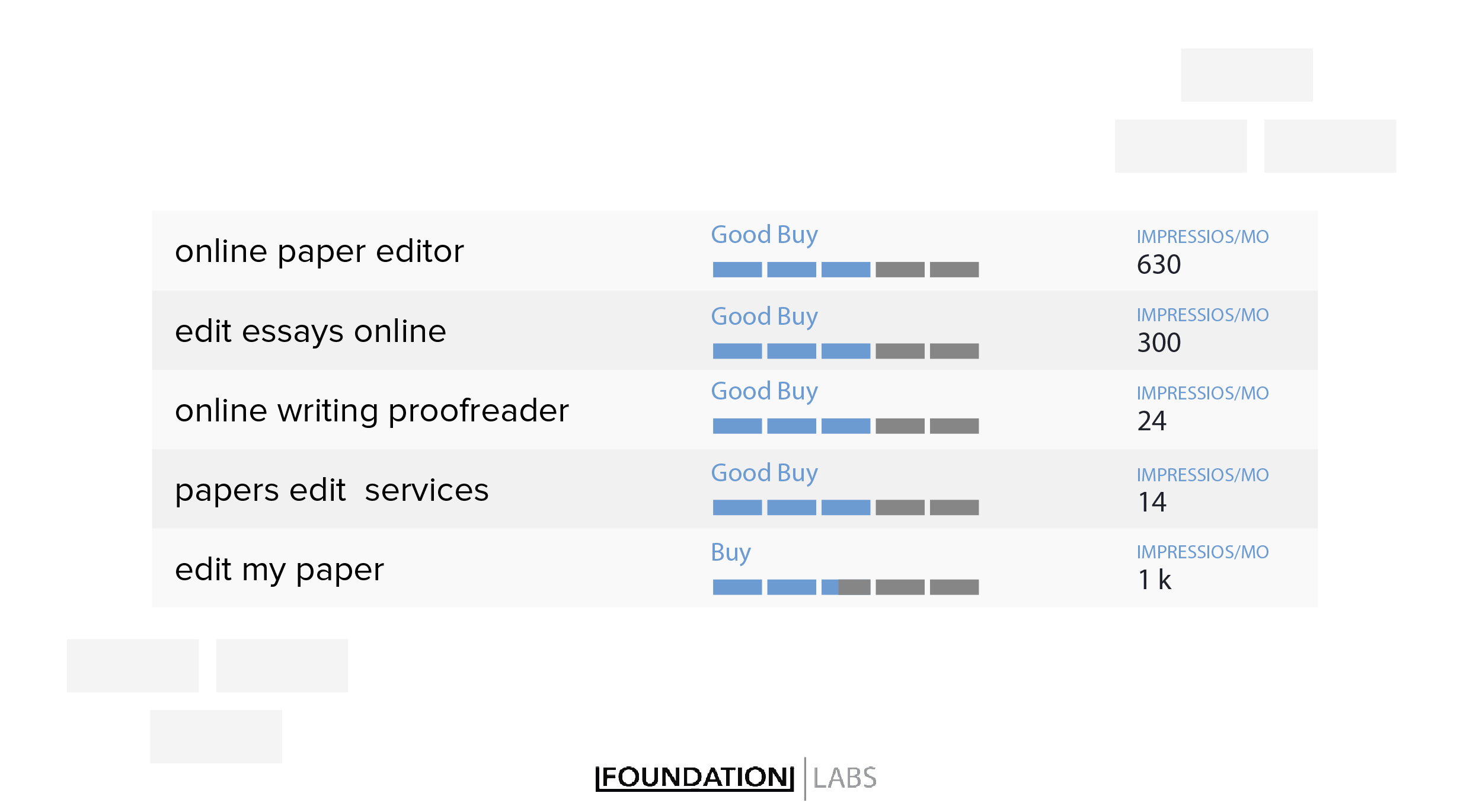

Upwork often lands the top spot on the SERP by incorporating the right keywords into highly relevant pages that Google considers superior to the millions of other potential results. Placement on the page is crucial because the top organic spot gets more than 28% of all clicks on average. Users want fast results and trust Google’s recommendations, so they’ll click at the first opportunity.
Beyond that, the clicks drop nearly half to 15% for the second result and 11% for the third. By the time you reach the tenth result, the click rate is only 2.5%. That’s a substantial performance gap between the first and tenth positions.
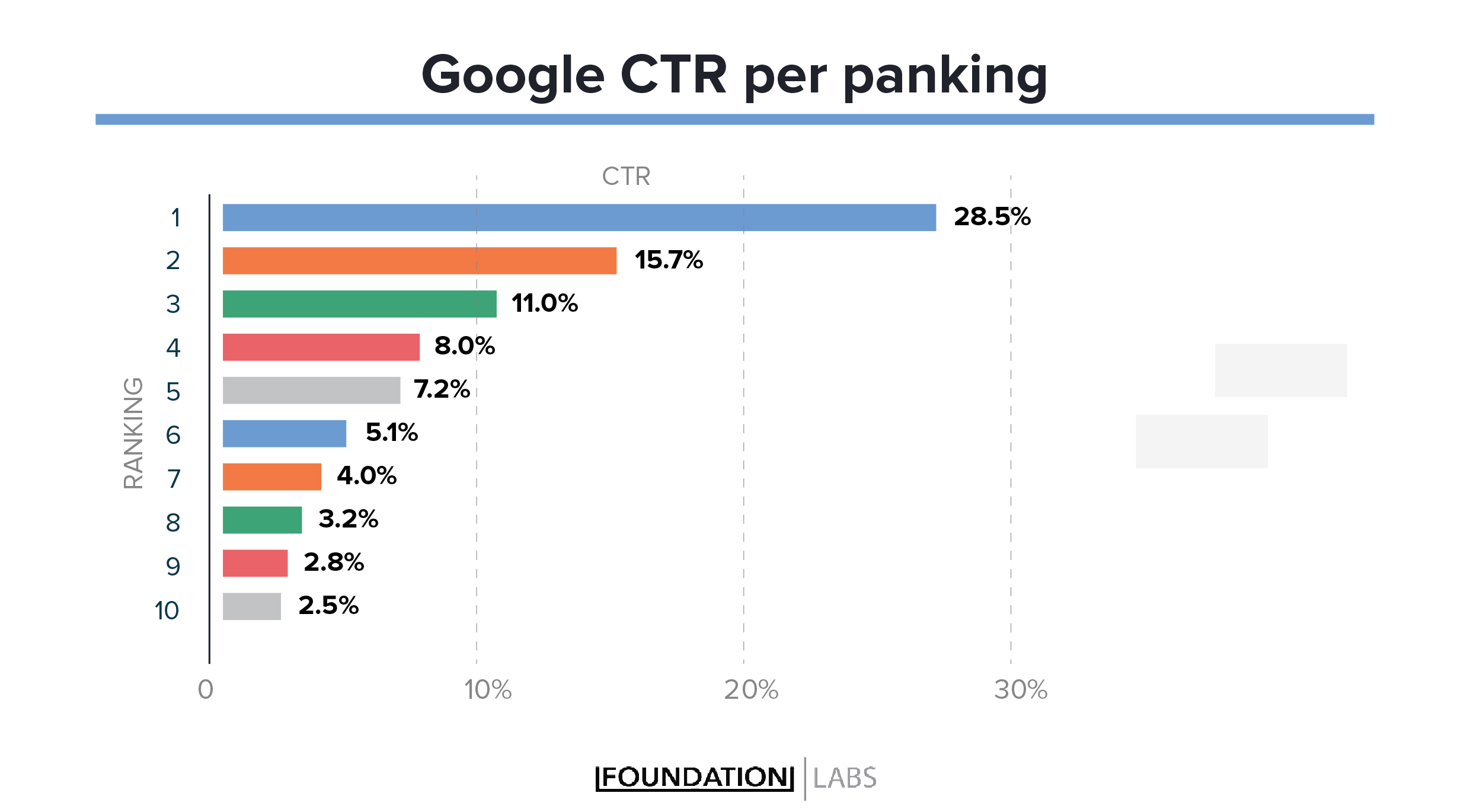

As a result, securing the top spot is a huge win for Upwork, and it positions them for long-term success because long-tail keywords are also easily replicable.
Templatizing Your Work for More Efficiency
Rather than diluting their efforts by using a generic term like “freelancers for hire,” Upwork targets several distinct searches using a format such as “freelance >job title< for hire.” They then create a landing page for each of these top freelancer roles, and the process is relatively easy because the bulk of the content on the pages can be the same.
Check out the landing page for “hire freelance copywriter”:
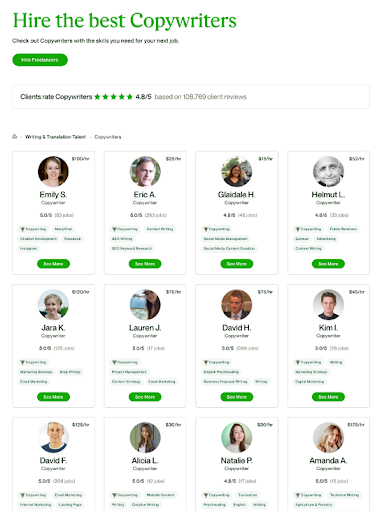

Source: Upwork.com
And here’s the landing page for “hire freelance graphic designer”:
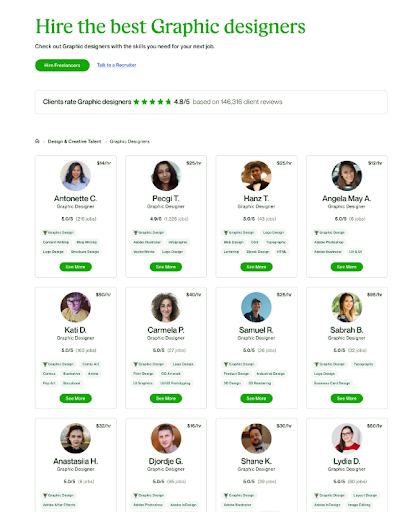

Source: Upwork.com
Upwork uses a templated layout that’s not only easy on the eyes but also easy on their web developers. The design work has already been done and all that needs to happen is for the right freelancers to be placed into the grid. Searching for other freelance roles yields a similar experience on Upwork’s website.
While some might argue that templatizing like this kills creativity and makes things less dynamic for the user, it’s important to consider the use case. When people are searching for someone to hire, they want a simple interface that makes it easy to get a snapshot of each freelancer.
Plus, design consistency is particularly beneficial to returning clients because they’ll know what to expect in their search and can have a more streamlined experience. Think of your web usage—if your go-to search engine is Google, you are probably an expert at scanning results and identifying what you need. If Google were to start alternating the layout of its SERP, you’d likely be thrown off balance and have a harder time deciphering the results.
You can potentially use a similar strategy for your website. Are there any product or service pages that could be templatized? If so, you could use long-tail keywords to screen users and find the most qualified traffic. Then you could rest easy knowing that the users who land on your pages were seeking something relevant to what you’re offering, not just a generalized term that is only tangentially related.
When creating templatized pages, be aware that you should still include some unique copy (sounds like an oxymoron, doesn’t it?). Simply reword the messaging, so it doesn’t get flagged by search engines as duplication, add a few customized portions related to the specific offering on the page, and you’d be ready for action.
What Keyword Strategy Does for Your Website
Upwork continues to dominate the highly competitive freelance marketplaces, showing that its strategies are working. The company has posted impressive year-over-year growth since its founding, bringing in more than $500 million in 2021.
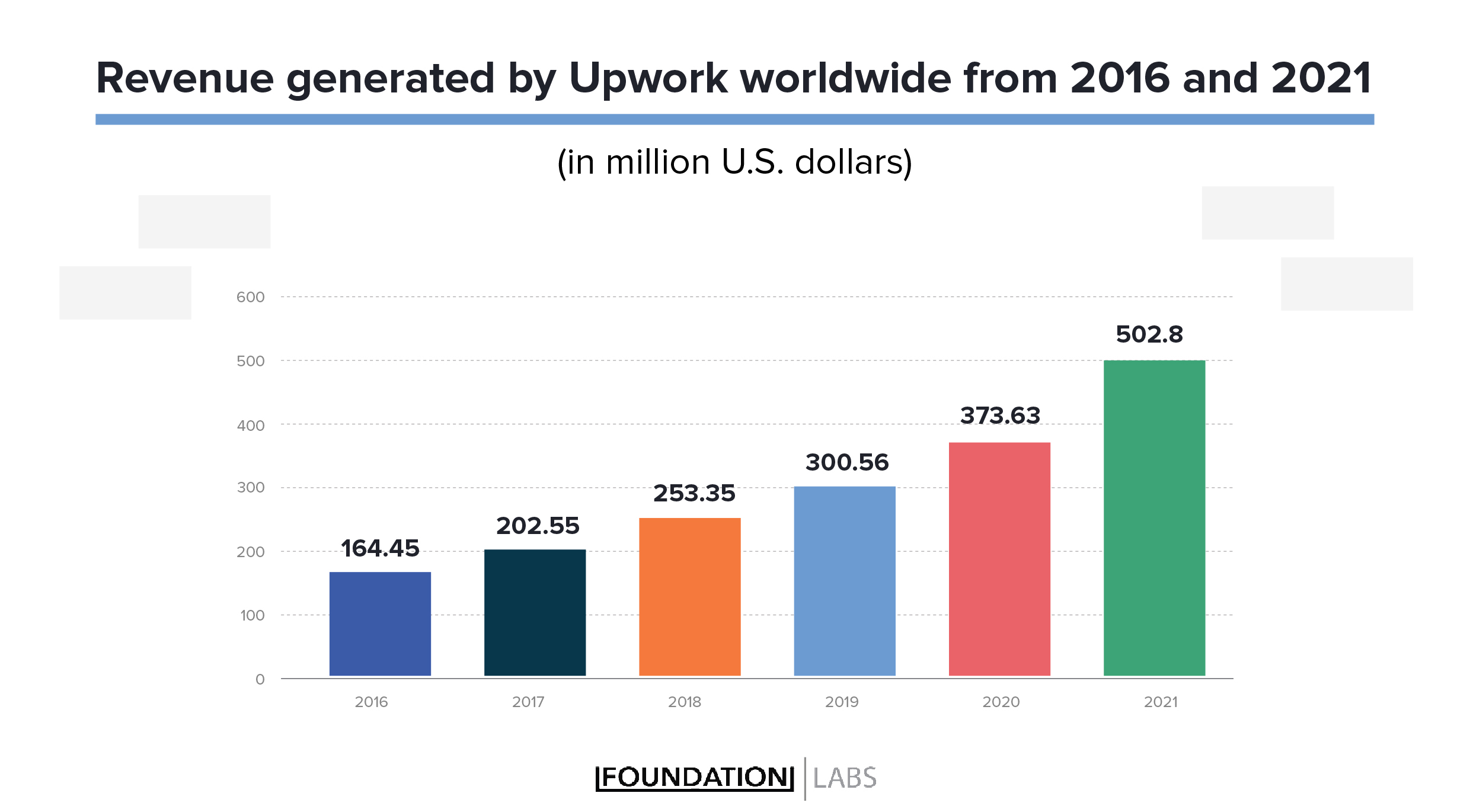

But we can learn more about the ground-level performance of their keyword strategies by focusing on their SEO performance. Their organic search traffic hovers in the six million range each month, easily topping most of their competitors.


Drawing in that much organic search traffic is impressive in its own right, but how the users respond to your website is where the full story is told. Metrics like time on site and bounce rate highlight the value you’re providing, and if they’re high, set the stage for ongoing customer satisfaction and loyalty.
Based on these key stats, Upwork’s visitors typically get the answers they’re looking for. First, users view more than five pages per visit to Upwork.com. Second, there’s a bounce rate of just .3. And finally, users linger for more than 20 minutes on the website per visit.
Compared to primary competitors like Fiverr and Freelancer.com, Upwork has posted the highest traffic peaks and consistently performed well.
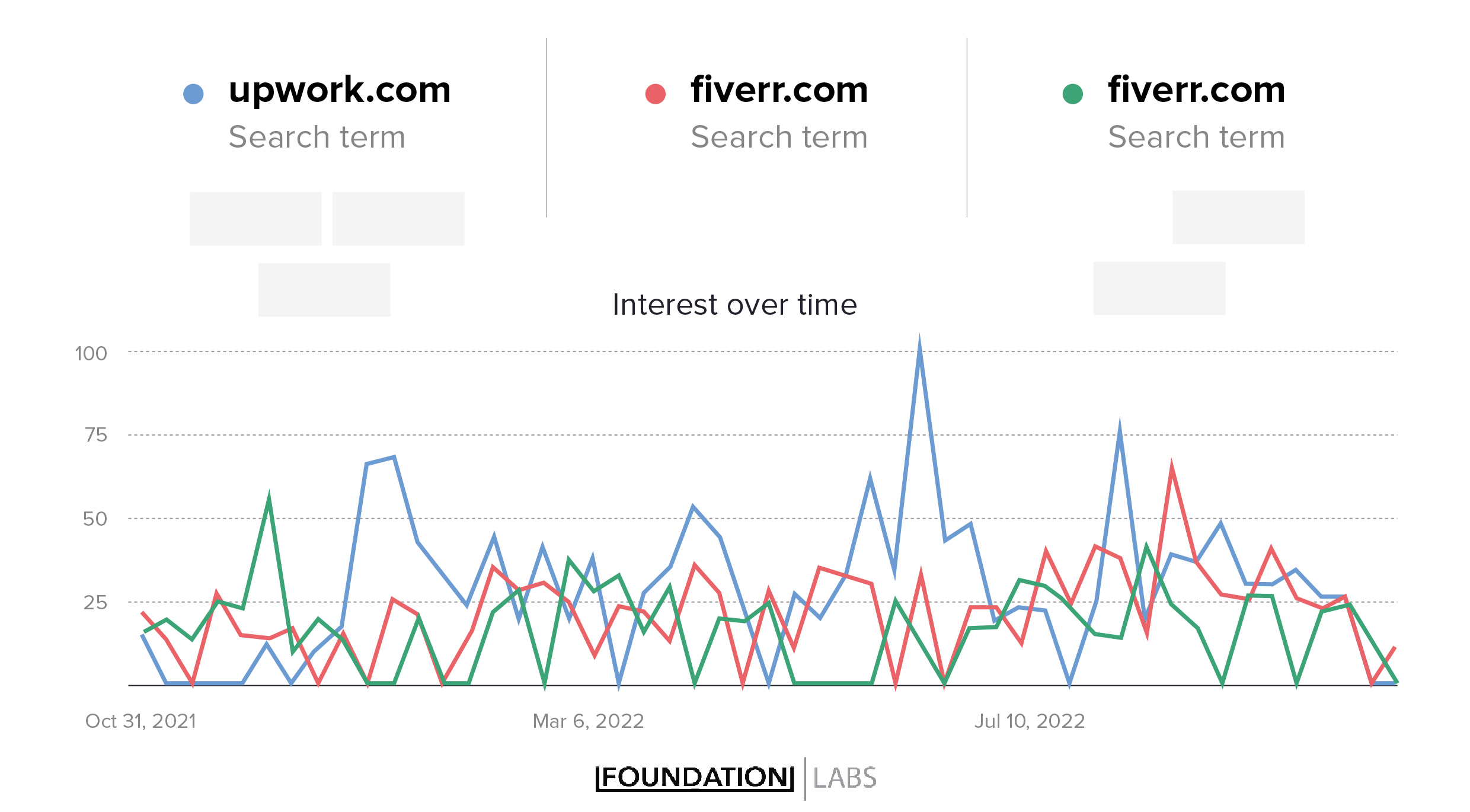

As you can see, however, Fiverr has made up ground in part by employing a similar strategy with long-tail keywords. With more platforms using skill-specific long-tail keywords, the battle for organic traffic in the freelance industry will only become fiercer.
There Are Still Benefits to Broader Strategies
The specificity of long-tail keywords allows you to deliver the right solutions to the right people. But there will always be benefits to also casting a wider net. In addition to using more general keywords in their SEO efforts, Upwork also uses broader messages in their Google Ads.
You can view four of their top-performing ads below.


Notice that the individual freelancers are referred to as “quality professionals,” “trusted professionals,” “top professionals,” “top talent,” and “experts.” There’s no need to specify roles such as programmer or videographer because these ads are being served up to a wide range of users who might not even know who they’re looking to hire at the moment.
A comprehensive approach that employs specific solutions and overall brand awareness is key to reaching new customers and providing a satisfying experience. Upwork excels in this area and has notably improved client retention in recent years.
It brings to mind the adage: you can please some of the people all of the time, you can please all of the people some of the time, but you can’t please all of the people all of the time. There’s truth to this statement. But Upwork’s SEO strategies are changing the equation to delighting the right people all of the time and intriguing all of the people some of the time.







